Content
- 1 Features of growing spinach
- 2 When to plant spinach outdoors: planting timing
- 3 How to plant spinach outdoors: preparation and planting
- 4 How to care for spinach after planting
- 5 When to harvest and how to store
- 6 Planting and caring for spinach outdoors in spring
- 7 Outdoor spinach care
- 8 Requirements for growing conditions
- 9 Through seedlings
- 10 Sowing in open ground or in a greenhouse
- 11 Autumn sowing
Spinach is a vegetable crop that contains a lot of useful vitamins in the leaves that are indispensable for the functioning of the human body. Therefore, gardeners who decide to switch to a healthy diet, sooner or later wonder how to plant a plant. In order for the planting of spinach to be successful, and the garden bed will soon become covered with juicy rosettes, you need to know everything about the specifics of growing a vegetable in the garden.

Features of growing spinach
It is better to plant the plant in early spring or in the fall, since at this time the temperature is kept within + 20- + 25 C. Spinach is sown closer to summer, however, in order for the bushes to grow quickly, the plantings have to be carefully looked after: often water and shade from burning sun. If you do not provide the greenery with comfortable conditions, the plant will start to stem. In the case when the desire to constantly have fresh herbs on the table overpowers the difficulties, spinach is planted every 15-20 days.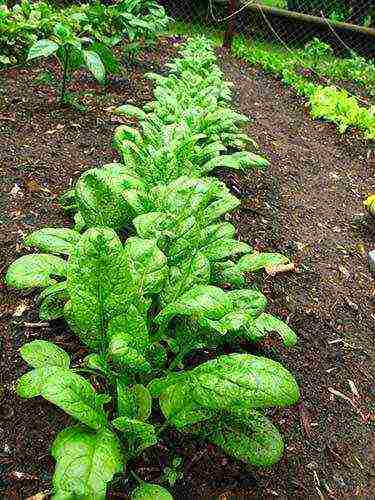
Note! Unlike most garden crops, spinach cannot be fertilized with fresh organic matter during its growth. Such dressings impair the taste of greens and, at a high dosage, can burn the roots of the bush.
When to plant spinach outdoors: planting timing
Since spinach is a cold-tolerant plant, spring planting outdoors is done immediately after the ground has thawed. As for the temperature, the sowing of spinach begins when it has warmed up to + 4-5 C. Depending on the climatic conditions of the region, as a rule, the crop is sown in the calendar period from March to June.
To harvest useful leaves in the fall, seeds are sown in mid-August.
In the fall before winter, spinach is planted on the site in September and October. The plant will release small leaves, overwinter safely, and in the spring, 2 weeks after the snow melts, the leaves are ready for use.
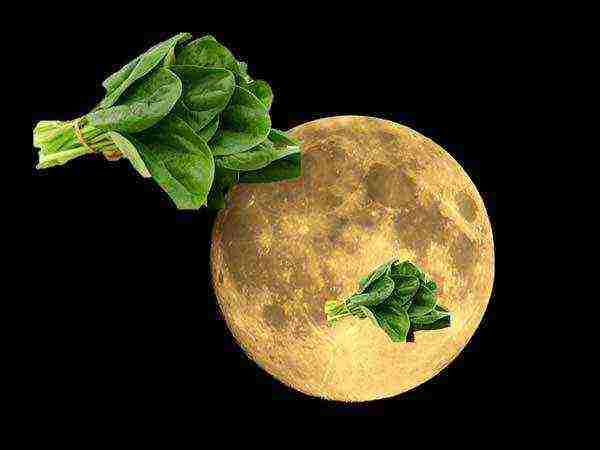
According to the lunar calendar in 2018, favorable days for planting spinach in open ground are:
- in March - from 8 to 11, 20 and 24;
- in April - from 7 to 11, 22, 23, 25, 26;
- in May - from 8 to 11, from 20 to 25;
- in June - from 5 to 9, from 19 to 25.
Unfavorable:
- in March - from 1 to 3, 16 and 30;
- in April - from 15th to 17th, 29th and 30th;
- in May - from 14 to 16, from 28 to 30;
- in June - from 12 to 14, from 28 to 30.
How to plant spinach outdoors: preparation and planting
The desire to acquire spinach in the garden can simply disappear after a few unsuccessful plantings. To prevent this from happening, you need to know all the requirements for growing this vegetable crop.
How to choose a seat for landing
It is better to plant spinach in lighted areas where water does not stagnate. To harvest as early as possible, the plant is placed on southern slopes that are protected from cold winds.
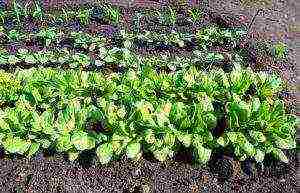
If, besides the lowland, there is nowhere to plant bushes, the culture is sown on ridges, which are fenced with boards of hard rock. Due to the fact that the root system of the plant is short, the embankment can be small.
Since spinach is compatible with most garden crops, there is practically no need to consider when choosing predecessors and neighbors. The only thing worth paying attention to is how the previous crop was fertilized - the more top dressing was added last year, the better for spinach. These rules apply to all cultivated plants, except for beets, since plants are susceptible to the same diseases and pests.
What soil is needed and how to prepare it
Spinach loves to grow on nutritious loose soil. Thus, the best soils for planting a plant with seeds are sandy loam and loamy soil, the acidity of which is 6.5-7 units. If the environment at the site is acidic, dolomite flour or organic matter is added to the soil. It is impossible to limy the soil, since the plant does not grow well after that. To improve the structure of heavy clay soils, rotted manure is preliminarily introduced.
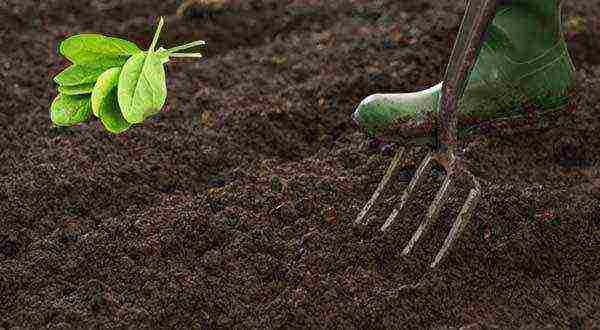
In the case when the soil meets the requirements, they begin to prepare the site for planting. In autumn, mineral fertilizers with a high content of potassium and phosphorus are applied to the soil. If desired, half the dose of nitrogen is added, and the rest is embedded in the soil in spring. Instead of purchased mixtures, the soil can be filled with compost or rotted manure. Organic consumption per 1 sq.m. beds - 6-7 kg.
If the soil on the plot is poor, then immediately before sowing, 1 sq.m. the area contributes 5 g of phosphorus, 7-9 g of nitrogen, 10-12 g of potassium.
Important! Spinach leaves have the ability to accumulate nitrates, so an excessive amount of nitrogen must not be added to the crop.
How to prepare seeds
To speed up the emergence of seedlings, the planting material is soaked in warm water. If the seeds of many crops are soaked for several hours, then spinach seeds are kept in water for 24-48 hours. This feature is due to the fact that the planting material is covered with a hard shell, through which moisture is difficult to absorb. The germination container is placed in a warm place and the water is periodically changed. At the end of the period, the spinach seeds taken out of the water are slightly dried and sown in open ground.
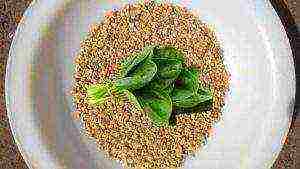
Direct landing
The first thing to do before planting spinach seeds in open ground is to loosen the soil with a rake and then level it. If the landing will be carried out on the ridges, an embankment is created at the selected place and fenced with improvised materials. On a prepared bed, rows of 2 cm long are made with a wooden plank. The optimal distance between rows is 15-20 cm, and between plants - 7-10 cm. Seed consumption for sowing is 1 sq. M. area - 4-5 g.
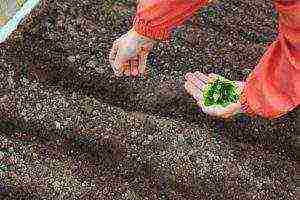
If you plant the bushes too densely, the plants will develop more slowly. To be sure that there are enough plants on the garden bed, and the place will not be empty, you can reduce the step between the bushes in the rows. However, if the seed germination rate is 100%, the plantings will have to be thinned out. The soil in the recess is watered with warm water, the seeds are laid out. Then the crops are carefully covered with a rake, at the same time slightly crushing the soil.
To reduce moisture evaporation and slow down the growth of weeds, the garden bed is mulched with hay, dry leaves, and chopped straw. If the planting is done correctly, and the weather is favorable, the first shoots will appear after 2 weeks.
Video: how to sow spinach correctly - timing
How to care for spinach after planting
For plants to produce a good harvest, they need to provide comfortable conditions for growth. What does spinach care after planting consist of?
Watering
The soil on which the greens grow should be constantly moist, but by no means swampy. Due to the constant overflow, the plants grow poorly and after a while are affected by root rot.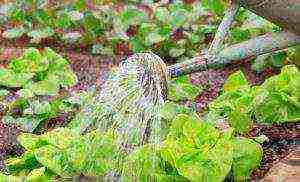
It is especially important to water the spinach during a hot season, as stemming begins due to insufficient moisture. Water the bushes 2-3 times a week. Water consumption per 1 sq. m beds - 3 liters.
Top dressing
During the growing season, it is not recommended to feed greens with fertilizers, which contain a large amount of phosphorus and potassium.
Leaves of plants that lack chemical elements gradually turn to a different color or die off.
The fertilizers selected for feeding spinach must be applied strictly in the dose recommended by the manufacturer, otherwise the excess of nutrients will provoke premature shooting.
Important! It is impossible to feed greens with fresh organic matter during growth, as it distorts the taste of the leaves.
Weeding and loosening
To grow even the most unpretentious crop, you need to pull out weeds as needed. As you know, these plants suck out a lot of nutrients from the soil and compact the soil, which has a bad effect on the state of the culture, and, accordingly, the yield. In the case when the distance between shoots is much less than 7-10 cm, the extra bushes are removed. To reduce stress on the surrounding bushes, water the garden bed sparingly after thinning.
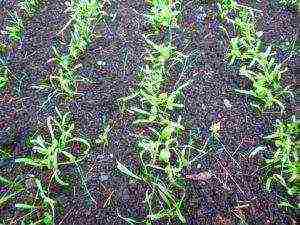
The first time the soil is loosened when the seedlings are 2-3 days old. To do this, they gently destroy the formed crust with a rake, thereby improving the aeration of the soil. In the future, loosening is carried out after each watering or rain.
Shelter in the heat
Since spinach does not tolerate the summer heat well, in July, when the air temperature often exceeds +26 C, the plantings need to be shaded. To cool the soil and bushes from overheating, a small awning is installed over the spinach plantation or the garden bed is covered with a special shading net.
Important! It is impossible to grow juicy leaves without abundant watering and the construction of a shelter. Under the influence of high temperature and lack of water, the leaves become hard and tasteless.
Spinach pests and diseases
Delicate leaves are enjoyed by aphids, miner flies and naked slugs. Do not mind eating greens and snails. Spinach growing in a thickened state suffers from downy mildew. Bushes become infected with spotting and root rot.
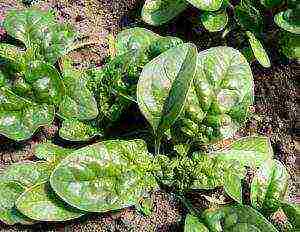
Since it is impossible to process greens with chemicals, it is better to try to prevent the appearance of pathogenic microorganisms. To protect the planting from damage, you need to properly care for them: water, loosen, weed. In order to prevent powdery mildew, the bushes are planted at a sufficient distance. Also, for planting, it is recommended to choose spinach varieties with high immunity to all kinds of diseases.
When to harvest and how to store
For spinach leaves to be tender and tasty, they need to be harvested on time. If the recommended dates are exceeded, the leaves will become tough and lose their original taste. Harvesting spinach from the bushes planted in spring begins 8-10 weeks after the seedlings emerge. Spinach planted in summer is cut 2 weeks later. Regarding the time of day, it is better to cut the sockets in the morning after they dry out from watering.
You can determine whether spinach is ready for harvesting by the type of bush - you can harvest greens immediately after the formation of 5-6 leaves on the plant, which appear 30-40 days after the seedlings appear.
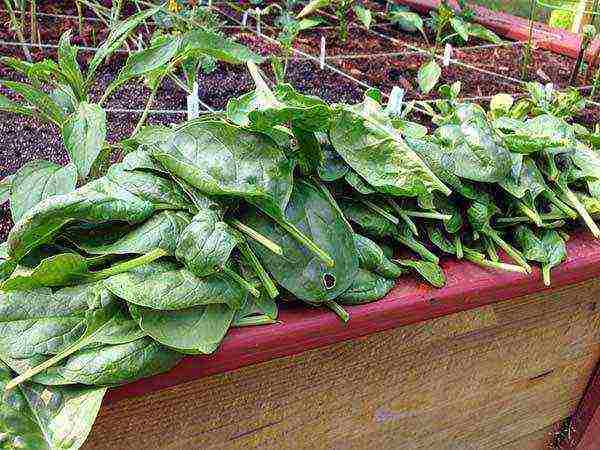
Spinach is harvested by cutting off individual leaves or a whole rosette. Also, the plant is uprooted. Before putting the plucked plants into containers, wash the rhizome, being careful not to splash the leaves. Then the washed part is blotted with a paper towel and placed in the box with the root down.
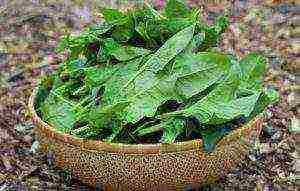
Important! It is impossible to harvest spinach immediately after watering or rain: wet leaves rot shortly after cutting.
For storage, spinach is placed in the upper compartment of the refrigerator. Since fresh leaves are stored on average for 1-2 weeks, they are dried, frozen or canned for the winter.
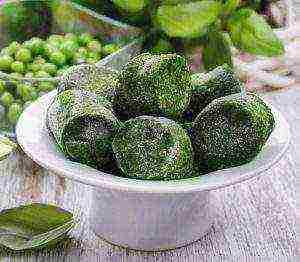
If you carefully understand the agrotechnical requirements, planting spinach will not cause difficulties even for an amateur gardener. All that an unpretentious culture needs for normal growth is a sufficient amount of moisture and fertile soil.
Video: all about growing spinach in the open field in the country
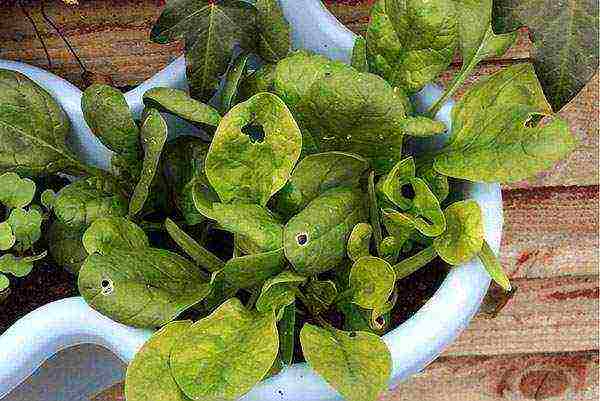 Thanks to the young leaves, rich in vitamins and minerals, the popularity of spinach has long and steadily been growing all over the world. It is difficult to find an equally useful and unpretentious plant like spinach, cultivation and care in the open field for which even novice summer residents can handle it.
Thanks to the young leaves, rich in vitamins and minerals, the popularity of spinach has long and steadily been growing all over the world. It is difficult to find an equally useful and unpretentious plant like spinach, cultivation and care in the open field for which even novice summer residents can handle it.
Spinach is one of the early ripening vegetables.From the moment of sowing to the collection of the first batch of leaves, it takes 30-40 days. At the same time, the plant tolerates cold well, does not require painstaking care. It is not surprising that during the warm period in most regions of the country, you can get not one, but several harvests. Both summer residents and large crop farms use this property of the plant.
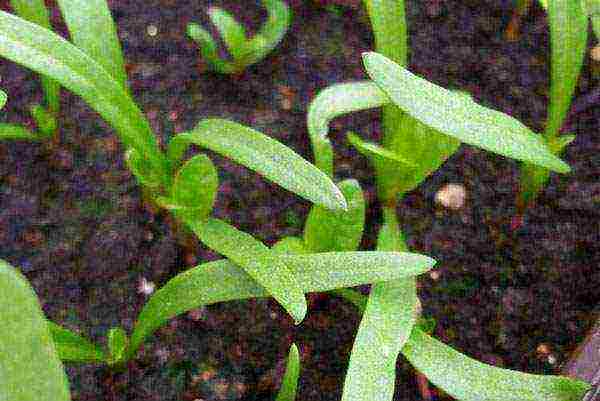 However, mastering the cultivation of spinach in the open field, you need to know that this is a short-day plant. When the duration of daylight hours exceeds 14 hours, spinach stops growing leaves, and forms a peduncle. Such plants are no longer used for food.
However, mastering the cultivation of spinach in the open field, you need to know that this is a short-day plant. When the duration of daylight hours exceeds 14 hours, spinach stops growing leaves, and forms a peduncle. Such plants are no longer used for food.
In order to pamper yourself and loved ones with healthy and tasty greens for as long as possible, you need to choose varieties that are most resistant to flowering and plant spinach in early spring, as well as from the second half of July to get an autumn harvest.
Planting and caring for spinach outdoors in spring
 You can grow spinach through homemade seedlings or by sowing seeds directly into the ground. The second method is used more often, and due to the cold resistance of the plant, the first spinach seeds fall into the soil as soon as it thaws well.
You can grow spinach through homemade seedlings or by sowing seeds directly into the ground. The second method is used more often, and due to the cold resistance of the plant, the first spinach seeds fall into the soil as soon as it thaws well.
In the middle lane, this occurs in mid-April. If the spring weather does not pamper with warmth, crops can be covered with non-woven fabric, under which the sprouts can withstand frosts down to –8 ° C.
To facilitate pecking and protect against infections, spinach seeds are kept in a warm pink solution of potassium permanganate for 12 to 18 hours before sowing, and then dried until they become free-flowing as before.
Spinach is sown to a depth of 1.5 to 3 cm. So that the seeds after watering do not turn out to be much deeper, after planting the soil is rolled in the beds. Leave at least 30 cm between individual rows, and 5–8 cm between the seeds. This will allow the plant to form a lush rosette and simplify the care of spinach when grown in the open field.
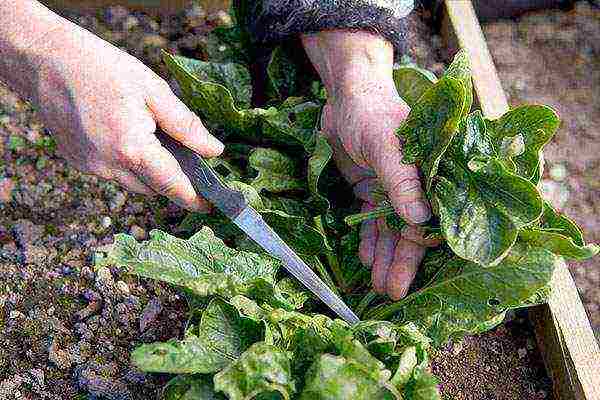 If the first sowing is in April, then the last summer is carried out at the end of June. Conveyor planting at intervals of 3-4 weeks will help you not lack fresh greens. From the last decade of July, crops are resumed and carried out until mid-August, and in the southern regions even until mid-September. Smooth lines of greenery in the beds appear 10-14 days after sowing.
If the first sowing is in April, then the last summer is carried out at the end of June. Conveyor planting at intervals of 3-4 weeks will help you not lack fresh greens. From the last decade of July, crops are resumed and carried out until mid-August, and in the southern regions even until mid-September. Smooth lines of greenery in the beds appear 10-14 days after sowing.
Taking advantage of the frost resistance of seeds and early ripening of spinach, it is planted before winter. The seeds are buried in the ground in October, and in the spring, immediately after the snow melts in the beds, the shoots of this useful and unpretentious plant will appear friendly.
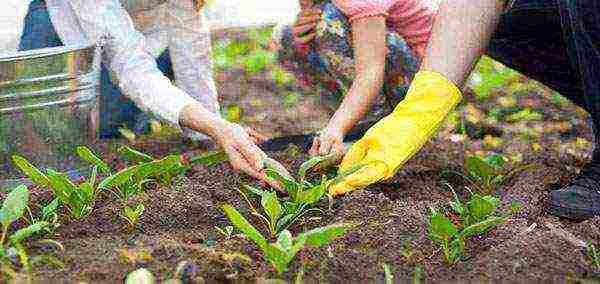 The success of spinach cultivation largely depends on the correct site selection and preliminary soil preparation. The plant prefers open, well-lit beds with aerated, slightly acidic soil that contains many nutrients.
The success of spinach cultivation largely depends on the correct site selection and preliminary soil preparation. The plant prefers open, well-lit beds with aerated, slightly acidic soil that contains many nutrients.
Autumn processing of ridges will help to increase the return on planting in the open field and caring for spinach in spring:
- they are dug deeply;
- add, if necessary for deoxidation, dolomite flour;
- the soil is mixed with fertilizers at the rate of 15 grams of potassium salts and 30 grams of superphosphate per square meter;
- when digging, add humus or manure.
In spring, on poor soils, the beds are additionally fertilized with nitrogen, adding 20 grams of urea per meter. Dense soil is mixed with sand and peat. This will make it easier to care for your spinach outdoors when grown outdoors.
Outdoor spinach care
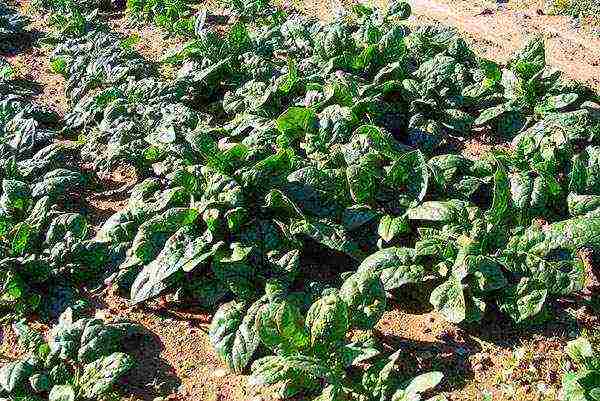 Caring for spinach is not too burdensome and consists of regular watering, weeding and loosening of the soil in the aisles. As long as the plants are small, it is important to avoid the formation of a dense crust that interferes with the formation of rosettes and the penetration of moisture.
Caring for spinach is not too burdensome and consists of regular watering, weeding and loosening of the soil in the aisles. As long as the plants are small, it is important to avoid the formation of a dense crust that interferes with the formation of rosettes and the penetration of moisture.
At the stage of 2-3 leaves, the plants are thinned out. If the seedlings are carefully removed, they can be transplanted by filling in the gaps elsewhere in the garden.
Watering the spinach should be abundant and frequent. In order not to harm the plantings, sprinklers are used.At the same time, up to 10 liters of water is consumed per square meter, which allows you to carefully and deeply saturate the soil with moisture.
Whatever the spinach variety, when grown outdoors, planting care necessarily includes protecting the plants from the scorching rays of the sun. When the air temperature rises above 26 ° C, the beds are hidden under non-woven fabric or other shading methods are used. If this measure is neglected, the risk of peduncles increases, the leaves lose their juiciness and coarse.
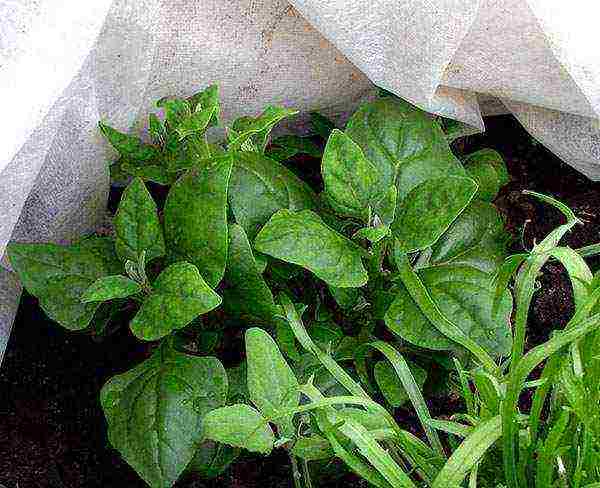 With proper preparation of the beds and sufficient nutrition, spinach grows quickly and after 2-3 weeks gives the first greener leaves to the table. If growth is inhibited, the leaf plates are small, the rosette is poorly formed, it is obvious that the plants need to be fed with nitrogen fertilizer. The granules must be sealed 2–5 cm deep into the soil, and then the beds are watered.
With proper preparation of the beds and sufficient nutrition, spinach grows quickly and after 2-3 weeks gives the first greener leaves to the table. If growth is inhibited, the leaf plates are small, the rosette is poorly formed, it is obvious that the plants need to be fed with nitrogen fertilizer. The granules must be sealed 2–5 cm deep into the soil, and then the beds are watered.
> 
Unlike vegetables and berry crops, growing greenery is not a troublesome and enjoyable activity at all. And if you know how to plant spinach correctly, then you can harvest it almost all year round.
Requirements for growing conditions
Spinach is a cold-resistant crop and even recovers after light frosts, so it can be grown not only in summer. Still spinach is a rather early ripening greens and appears one of the first on our table in May, and if it is planted with seedlings, then even earlier. In addition, spinach grows well next to most garden plantings, which means there is a place for it in any area.
Spinach is a cold-resistant crop and even recovers from light frosts
A small overview of popular varieties:
- Virofle - early ripening, it takes up to 20 days from germination to harvest. Bushes grow up to 30 cm in diameter, delicate, greenish-yellow in color. Disadvantage - quickly kicks out the arrow.
- Godry - the crop can be harvested in 18 days and within a month. Suitable for growing in greenhouses and for outdoor use. Rosettes about 25 cm.
- Strong - mid-season, ripening period is from 25 to 30 days. A large harvest can be expected with regular watering, flower steles are released late.
- Giant is an early and very productive variety. Two weeks after sprouting, the first greens can be harvested, and this despite the fact that the rosettes of such spinach can grow from 15 to 50 cm. Ideal for thermal processing and canning.
- Matador is perhaps the most common spinach variety, thanks to its early ripening and abundant fat-leaved greens with excellent taste. It is planted both through seedlings and in open ground from spring to late autumn. Blooms late.
Spinach is best sown in sunny areas. Any soil is suitable, the only exception is clayey and with an increased level of acidity. Regarding humidity, regular watering is necessary, it is on this that the yield of spinach beds often depends.
Now, having decided on the basic growing conditions, it is worth considering several methods: planting seedlings, sowing in open ground in early spring or before winter.
Video about properties and cultivation
Through seedlings
Early greens will be provided by a seedling method of growing. To do this, in late March and early April, spinach seeds are sown in boxes, plastic or paper cups filled with prepared soil. The seeds are not deeply buried; it is enough to cover them with 1 cm of moist soil and compact it a little so that the emerging roots will be easier to consolidate in the ground. After that, it is recommended to cover the containers with a transparent film or a piece of glass and put them in a warm place (for example, on a radiator) so that the "greenhouse" climate accelerates germination of seedlings.
Early greens will be provided by the seedling method of growing
After the appearance of the first sprouts, the shelter is removed, and the seedlings are rearranged to the southern or southeastern window sill, providing maximum illumination.Given the cold tolerance of spinach, it can be grown on a loggia, balcony or veranda, which is especially convenient if all the windows are already occupied by growing peppers, tomatoes and eggplants. Just remember to water your crops regularly.
Seedlings are planted in open ground when the soil warms up a little and the sun begins to warm up. After transplanting and watering, you can put arcs on top and cover the bed with non-woven agrofibre in order to protect the transplanted plants from intense sunlight at first and somehow "smooth out" night and day changes in air temperature.
Sowing in open ground or in a greenhouse
Sowing spinach seeds in greenhouses is considered the best option for getting early greens. In this case, the sowing time depends on several indicators, including:
- On the climatic features of your region, including the spring weather of the current year.
- From the quality and arrangement of the greenhouse. Obviously, vegetables can be grown in heated greenhouses with artificial lighting at least all year round. On spring sunny days in glass greenhouses, the air warms up faster and keeps the temperature longer at night. Modern polycarbonate structures are practically not inferior to them in these indicators. But the budget version of the film shelter will not keep warm well, especially if there are frequent frosts at night. In an effort to somewhat improve such designs, some gardeners use the densest film, and the roof of the greenhouse is covered with two layers, thus creating an air gap for better heat retention.
- From varietal characteristics of seeds.
On spring sunny days in glass greenhouses, the air warms up faster and keeps the temperature longer at night
Usually, work in greenhouses begins if the air in it warms up enough during the daytime. For spinach germination, such conditions are quite suitable. In addition, before sowing the hole, it is recommended to generously pour hot water, wait until it is completely absorbed, sow seeds and cover with a 1.5-2 cm layer of soil. From above, the rows are covered with a piece of agrofibre, which will help to maintain both heat and the required level of humidity. After the appearance of the first shoots, the shelter is removed. Work in the open field is carried out in a similar way.
In early spring, spinach seeds are sown in the garden, simultaneously with planting radishes, lettuce and onions on greens. In this growing method, moisture is the key to a successful harvest. Therefore, even during sowing, the grooves or holes are pre-watered, especially if the soil is dry. This will help to soften the sufficiently dense shell of the seed faster, and subsequently provide the forming plants with moisture. When the spinach is already ripe, it needs frequent watering, especially on warm and sunny days.
Spinach usually sprouts together and at the same time, so if you want to extend its harvest period, sow it gradually, at intervals of 7-10 days. So you will have young greens for a long time. If you need to save space on the site, spinach can be sown as a thickener, for example, between beans, tomatoes, dill, radishes or carrots. Thus, while the main crops are growing, you will already have harvested spinach.
Video about growing spinach, lettuce and basil
Autumn sowing
Experienced gardeners know how many worries spring brings, so they try to do some work since autumn. So, many cold-resistant crops can be sown podzima, for example, carrots, garlic, radishes, sorrel and, of course, spinach. The advantages of such plantings are obvious: there is enough time in the fall, there is a lot of free space on the site, and most importantly, the soil is saturated with moisture both during sowing and during spring growth.
Many people worry that the sprouted green shoots may die in winter, but fears are in vain - as soon as the snow melts and the April sun warms up in spring, the planting of spinach will quickly recover and delight you with the first greens from your own garden.
Rate the article:
(1 vote, average: 5 out of 5)
This culture combines the main characteristics for a gardener-gardener: a healthy and tasty leafy vegetable, while completely unpretentious in care. Prepare the soil before planting the plant. 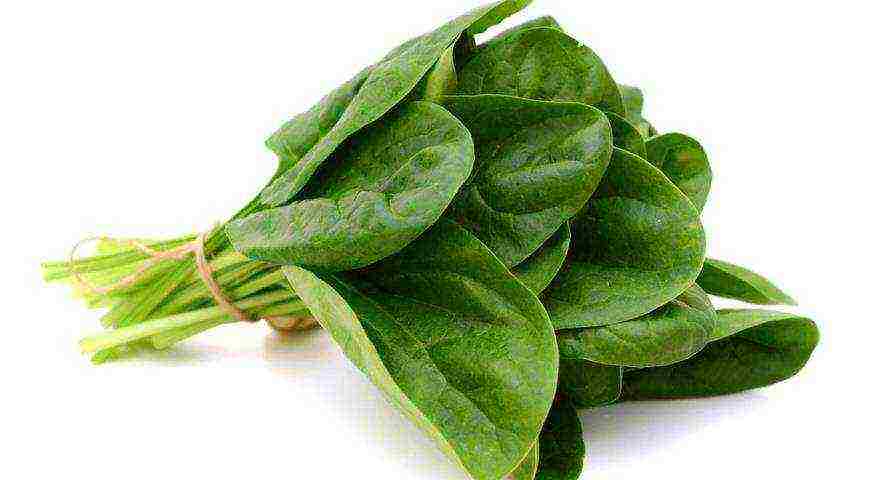
In order to grow this vegetable, it is not necessary to cook and allocate a lot of space on the site. The smallest area will be enough for plants; for these purposes, a flower bed in the garden, which spinach will decorate with its dark green foliage, may well be suitable.
For successful cultivation and abundant fruiting of spinach leafy greens, an enriched and loose soil is needed. And the main condition for favorable cultivation is a high level of air and water permeability of the soil.
Loamy soil is considered fertile for planting, while a dense mixture with an earthen crust is absolutely unsuitable for growing a spinach culture. The acidity of the land is one of the important factors affecting the volume of the vegetable harvest.
The best indicator is the neutral level of acidity of the soil mixture. In the spring, before planting, the site is cultivated for sowing crops.
If we talk about the history of the site on which it is planned to plant seeds of leafy greenery, then the following are considered favorable predecessors: cucumbers, tomatoes, zucchini, asparagus, beans, lentils. To plant a leafy vegetable, it is necessary to allocate an area with abundant access to sunlight.
From the video you will learn how to sow spinach.
Since spinach ripens quickly, fertilizers that will be used for feeding should be effective and fast. For these purposes, at the beginning of March, urea in granules should be scattered over the area chosen for planting the culture.
The next step in fertilizing the land will be to add humus to the area where the seeds are to be planted. 
There is also a method for preparing an open field spinach in autumn, which is used by many gardeners. To do this, in the fall, potash and phosphorus fertilizers are distributed over the surface of the site, together with humus or rotted manure, for each square meter of the future site for sowing. This land enrichment is carried out with simultaneous digging of soil.
If the leafy vegetable will be planted in an area that does not contain black soil. Before sowing, the following mineral fertilizers should be applied: 15 g of potassium, 7 g of phosphorus, 10 g of nitrogen. The dosage of the components is calculated per 1 m2. Considering that spinach leaves tend to accumulate nitrates, it is not worth using nitrogen-containing fertilizers in the spring.
How to grow spinach in your vegetable garden? Most often it is grown from seeds. Before planting spinach, prepare its seeds for planting. And you need to do this correctly, otherwise you may not wait for the long-awaited shoots.
The seeds are soaked for several days in warm water, after which they are soaked, dried and sown on the site. Sow the culture either in beds or in rows. The first option is optimal for planting in an area with heavy, dense soil, and the second for more airy and favorable soil. 
The planting material for spinach (seeds) is deepened 2.5-3.5 cm deep into the soil, leaving the row spacing at a level of 30 cm.
Since spinach is a cold-resistant crop, it is advisable to start the first crops immediately after the snow melts, that is, it is already possible even at a temperature of +4 ° С. Under these conditions, the seeds germinate quite successfully.
The method of growing spinach is identical with radishes, so very often these plants grow with each other.
With the best development of events, the first harvest from young leaves will actually be harvested after 30-40 days from the first sprouts pecking.
Planting of spinach is carried out from mid-April to mid-May, but of course, it all depends on the climate and geographic location of the region.
If we take into account the plant's need for moisture, then late planting, in dry soil, will not bring the desired results. Heat and dry weather for this culture is contraindicated. For this purpose, the principle is used the sooner the better.
When the soil for sowing is ready, in order to obtain a constant harvest, the plant is planted at the end of August. In this case, you can enjoy the first leaves in the spring.
In a plant planted before the onset of the first frost, the first shoots will hatch, as a rule, at speed. Then the plant overwinters safely, and when the spring snow melts, in two weeks, it will be possible to harvest a full harvest from fresh, green, juicy leaves. 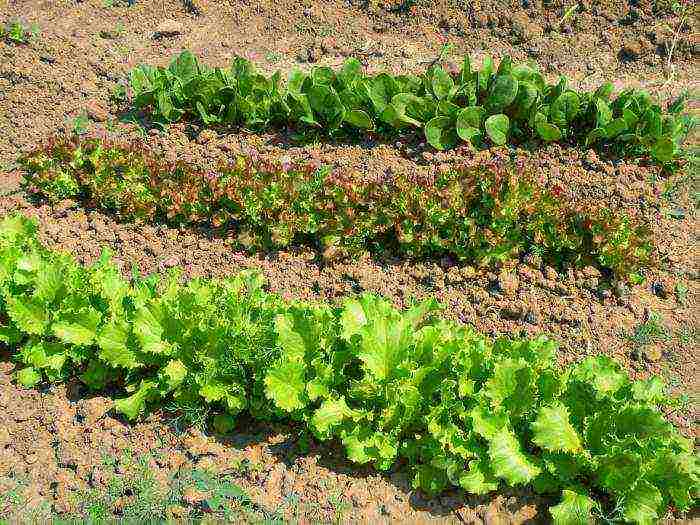
September crops will sprout this year and will overwinter practically without problems. With the arrival of spring, they will thaw and begin to grow intensively. When planted in October, green petals will ripen in mid-autumn. To ensure a harvest within six months - from spring to autumn, it is necessary to select the optimal varieties and sow seeds from time to time.
In order for the plant to develop correctly, and the vegetation process to proceed harmoniously, and nothing bothers it, you should take care of spinach in the open field, competently and competently. You need to start caring for planted leafy vegetables by thinning the rows and beds on which the culture grows.
Thinning takes place by removing excess, weaker seedlings, thus leaving a distance of 8-10 cm in the phase of two true leaves. Seedlings should be tried to thin out as early as possible, since in thickened rows they can bloom quickly, and all the plant's strength will go to the formation of flowers first, and then seeds. 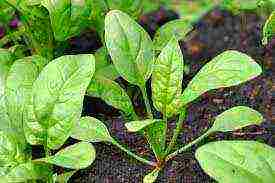
When the plants begin to come into contact with each other, a second thinning is carried out, leaving gaps of 15 cm. The removed plants can be eaten. The culture during the growth period also needs fertilizing with ammonium nitrate, which is produced at the rate (10-25 g per 1 m2).
The next step in the care is to clean the area from weeds and irrigate the soil. During periods of drought, watering is a must. Also spinach is extremely susceptible to lack of moisture, being at the stage of seed pecking and after the leaves have formed. Regular, timely watering prevents the formation of arrows on the shoots.
In order to obtain a large yield of spinach, a pinch is made on the upper leaves of adult plants, which will stimulate the vegetation of new shoots. The soil between the rows needs periodic loosening. In order to protect leafy vegetables from such ailments as: downy mildew, leaf aphids, beet jaundice, you need to understand that wet weather contributes to these lesions. 
The leaves of the culture are affected by the beet nematode, a common ailment with beets. In order to prevent such a misfortune, procedures are performed to combat aphids and isolation from the host plants of the disease, beets in this case.
Harvesting can be started if the leaves are of the correct size, that is, when 4-6 leaves are formed on the crop. Young and fragile leaves are removed first. Thus, the constant collection stimulates the growth of new shoots.
Summer varieties remove up to half of the leaves, while winter varieties are collected carefully, as they are very fragile, and are removed by hand.
For eating, you need large shoots of spinach, which do not yet have stems.
You can harvest the entire crop at once or in part by plucking the leaves as they form, in which case the collection of the leaves will last for weeks.
With spinach leaves, you should be extremely careful, do not tear, but slightly break off so as not to uproot the plant. 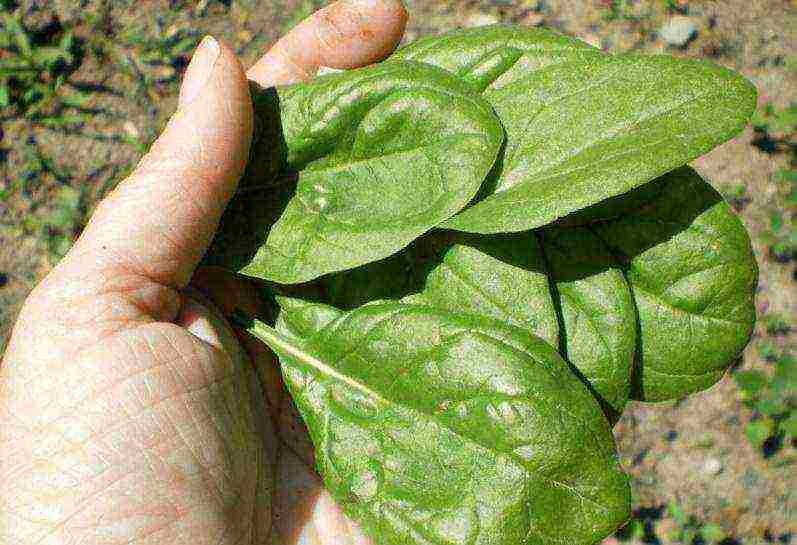
In the conditions of a leafy vegetable densely planted in a garden bed, when its rosettes are cramped, young seedlings are plucked, thus thinning is carried out. Young plants are quite edible.
The best time to harvest spinach is in the morning or evening, while plucked leaves during the day can quickly wither and become lethargic. Harvesting spinach when it rains is not recommended; wet leaves may start to rot.
If a lot of spinach has grown or there is a need to free up an area for planting other vegetables, root crops, then it is plucked along with the root, folding it into the container with the roots down.
The root of the plant is washed (water should not get on the leaves), blot it with a napkin.
Spinach is stored in the refrigerator in polyethylene or in a plastic container for no more than a day.
It is not worth wetting and washing the leaves before placing them in the chamber, this will shorten their storage time.
When transporting crops over long distances, ice is placed in containers with leaves.
Spinach leaves are best eaten fresh, immediately after harvest. 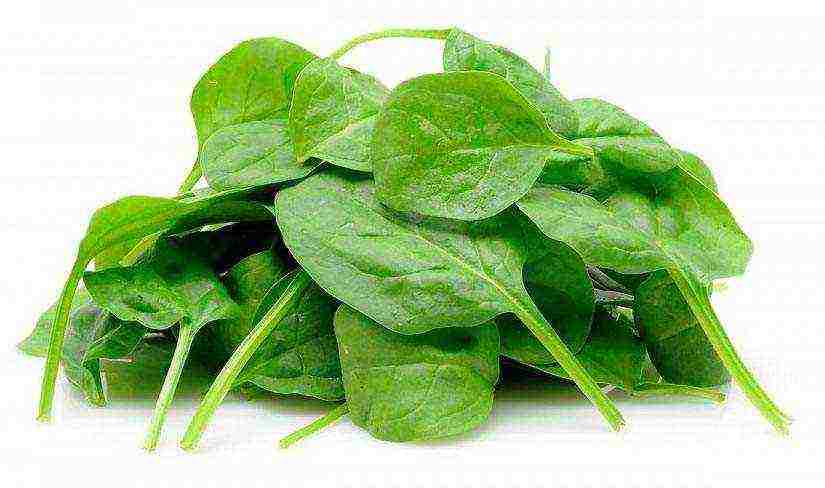
The plant contains many useful components: fiber, organic acids, a balanced multivitamin complex: vitamins A, C, B, folic acid, high content of vitamin E, minerals - iron, potassium, magnesium.
The use of leaves has a beneficial effect on the body in order to prevent gastrointestinal diseases, anemia, diabetes mellitus, hypertension. Fiber of the leaves enhances intestinal peristalsis, improves digestion, etc.
The leafy vegetable spinach, unfortunately, does not keep fresh for long. And in order to consume such green shoots valuable for the human body in winter, they are dried, canned, frozen.
This video will show you how to care for spinach.


